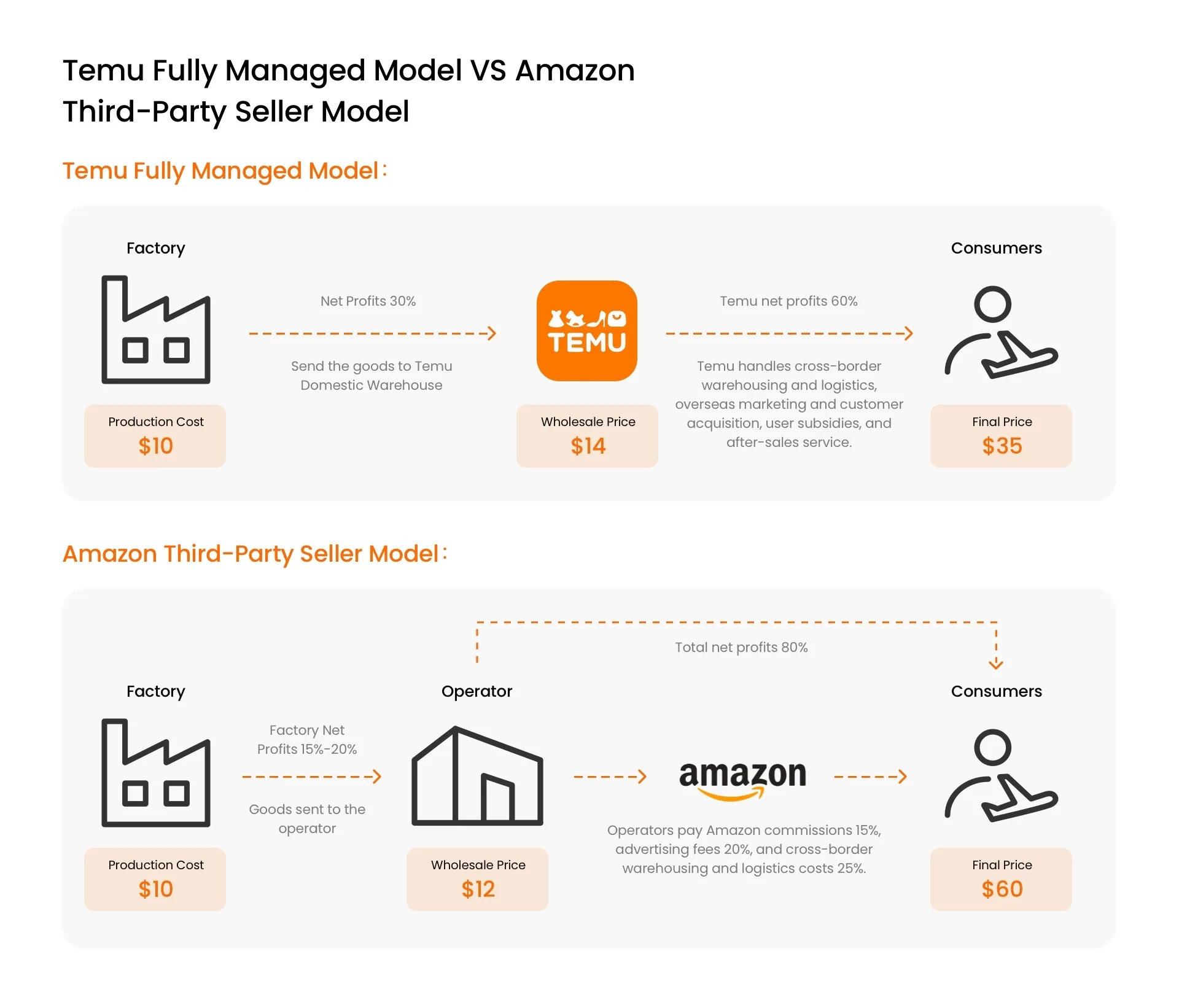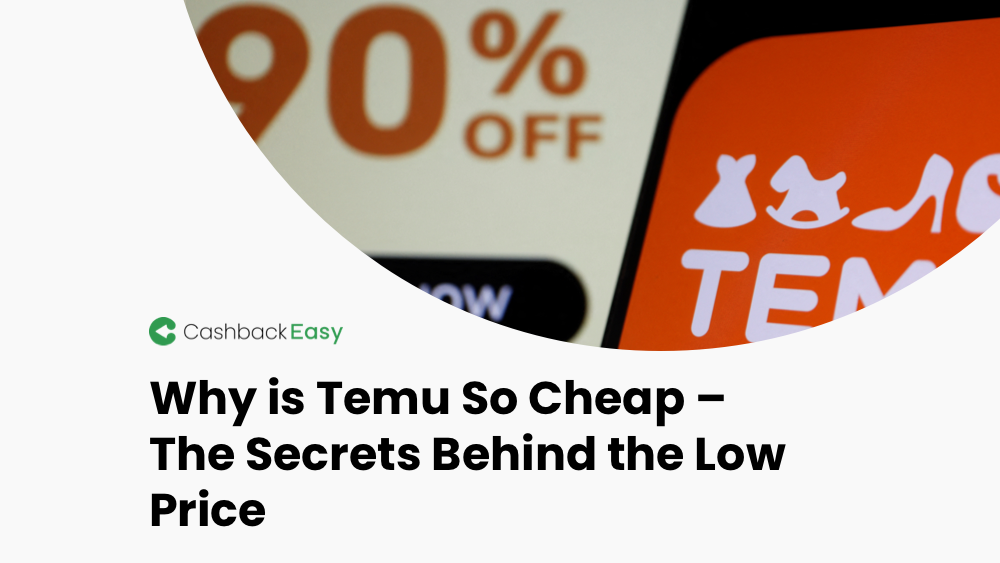Table of Content
The term “Temu” was coined by Pinduoduo – a Chinese e-commerce platform, and doesn’t exist in the English language, which is why many people are unfamiliar with it and curious about its meaning, some people have even asked, “Who is Temu?”. The word actually originates from “Team Up, Price Down,” which aligns closely with Pinduoduo’s slogan, emphasizing collective buying for lower prices; the more you buy, the more you save. The strategy focuses on small profits but quick turnover.
Temu entered the public eye in September 2022 and immediately caused a stir, surprising everyone with its incredibly low prices. This is the core of Temu’s business model, which centers on offering extreme value for money, mirroring the strategic approach of its parent company. Now, let’s delve into why the stuff on Temu can be so cheap. There are four main reasons

Reducing Intermediaries
One of the main reasons Temu can offer such low prices is by cutting out intermediaries. Products go directly from manufacturers to overseas consumers, ensuring consistently low and healthy prices.
In traditional cross-border e-commerce, costs related to labor and logistics can account for up to 30% of a product’s price, but on Temu, this is reduced to just 10%. Temu employs a fully managed model where sellers only need to focus on pricing and manufacturing their products. They then send their products to Temu’s warehouse in Guangzhou, China; and the platform handles everything else—export, marketing, fulfillment, after-sales service, and pricing.
This approach significantly reduces operational burdens for sellers, as they no longer need to worry about storage, logistics, and order processing. Sellers can concentrate on improving their products and pricing. Particularly for Chinese factories, this maximizes supply chain advantages, lowers costs, and offer cash back to consumers. Get Temu cashback here.

Bidding Mechanism
Temu utilizes a fully managed model that lowers the barrier for cross-border e-commerce to the minimum. Under this model, domestic sellers only need to focus on the design and production of their products, while the platform handles everything else. However, this also means that sellers lose the crucial ability to set their own prices.
Temu introduces a bidding mechanism to encourage competition among sellers to offer the lowest prices. Sellers who can provide the best prices get their products stocked. Once selected, the products are sent to Temu’s domestic warehouse, and Temu takes care of the rest. This model allows even those who know nothing about cross-border e-commerce or speak no English to supply goods to Temu and enter the cross-border e-commerce market.This model shortens the supply chain, as products go directly from factories to consumers through the platform. This inherently gives Temu a competitive edge over other platforms.
Additionally, by bringing in a large number of suppliers and selecting the most competitive products through bidding, Temu reduces costs through economies of scale in operations, marketing, shipping, and last-mile delivery, squeezing the profits of all participants to the maximum extent.
For example, if one seller offers a product at $5 and another offers it at $4.90 with the same quality, Temu will choose the $4.90 seller. This forces the $5 seller to optimize costs and lower their price. Once they lower it to $4.80, the previous $4.90 seller might reduce their cost to $4.70. This cycle continues, creating a competitive environment where sellers continuously lower their prices, ultimately reaching an industry-low price, which is Temu’s goal.
For suppliers, Temu continually enhances its automated bidding system. Under the current bidding rules, the platform holds a product bidding session once a week. The lowest-priced product of the same type wins and receives more traffic support. Products that fail to win the bid are restricted from restocking and listing new items. If a seller consistently fails to win bids, Temu will return the seller’s stocked goods.
Low Logistics Cost
Temu’s logistics and fulfillment process consists of three parts. First is the domestic transport phase, where sellers can choose between the VMI (Vendor Managed Inventory) model, which involves pre-stocking goods, or the JIT (Just-In-Time) model, which involves shipping goods to domestic warehouses based on actual orders. The shipping costs for this phase are shared between Temu and the seller.
The second phase involves mainline transportation, where Temu uses partnered logistics service providers to transport goods from domestic warehouses to overseas transit hubs. This phase includes customs clearance, collection by logistics companies, air transportation, and ground transit.
The final phase is the last-mile delivery to the customer, which is handled by third-party logistics partners. Temu takes full responsibility for these last two phases, so sellers do not need to worry about the logistics or the costs involved.
Initially, Temu used logistics service providers like J&T Express and YunExpress to offer full-chain services for mainline transportation. However, Temu now increasingly procures transportation capacity in segments to reduce costs and mitigate risks.
Temu also has a pricing system for logistics providers, with a core principle that prices can only decrease, not increase, within a month. Additionally, Temu focuses on selling small, lightweight products, which not only helps reduce logistics costs but also significantly improves transportation efficiency.
Customs Policy Benefits
A crucial factor in Temu’s growth is the U.S. “de minimis” customs duty exemption policy. In 2016, then-President Obama signed legislation raising the duty-free limit for overseas imports into the U.S. from $200 to $800. This move further reduced the cost of consumption for American consumers, allowing them to purchase high-quality, affordable imported goods. For Chinese e-commerce platforms, the $800 threshold covers the vast majority of categories in cross-border small parcels, including 3C products, clothing, shoes, bags, daily necessities, and small appliances, which can all be shipped directly to U.S. consumers by air. As a result, both Temu and SHEIN have been major beneficiaries of this exemption rule. U.S. customs data shows that in 2023, up to 1 billion parcels entered the U.S. under the “de minimis” rule, with one-third coming from Temu and SHEIN.
Currently, Chinese cross-border e-commerce logistics primarily operates under two models: direct mail and overseas warehouses.
Direct Mail: Goods are shipped directly from Chinese warehouses to U.S. consumers using international small parcel channels.
Overseas Warehouses: Goods are transported in bulk to local overseas warehouses by freight companies and then delivered to consumers by local courier services.
Small and medium-sized sellers often use the direct mail model to conduct their cross-border e-commerce business, while larger platforms and enterprises have the financial resources to utilize the overseas warehouse model for cross-border logistics fulfillment. At present, Temu predominantly uses the cross-border direct mail model, leveraging the “de minimis” policy. This allows their exported goods to the U.S. to benefit from tax exemptions.

Summary
The reasons behind Temu’s remarkably low prices can be summarized as four reasons above. In general, Temu is clearly using a low-price strategy to quickly penetrate the market and enhance brand awareness, actively seeking ways to minimize costs. This approach, however, is a double-edged sword. On one hand, the low prices have indeed attracted a large number of users; on the other hand, focusing solely on the lowest prices without stringent quality control can lead to an influx of subpar products, resulting in a mixed quality of goods on Temu.
Following the strategic approach of its parent company, Pinduoduo, Temu is likely to first capture the market with price advantages and then introduce branded stores to improve the overall quality of its products. About seven months after its launch, Temu began to bring in key account (KA) merchants and announced the recruitment criteria for KA merchants. They established dedicated departments to liaise with well-known domestic brands and brands registered on Amazon and independent sites, providing one-on-one solutions to merchants’ needs. It is clear that Temu will gradually take steps to enhance its reputation and improve product quality over time.
You May Also Like
Why Does Temu Take So Long to Ship – Temu Shipping FAQs
Temu App – All You Need to Know
All You Need to Know before Making a Temu Return

